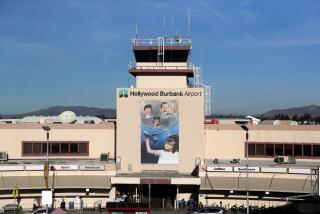FAA Seeks Tighter Reins on Private-Plane Traffic
- Share via
Under rule changes proposed by the Federal Aviation Administration, private pilots who now fly free as birds over much of the San Fernando and San Gabriel valleys would be required to check in with air-traffic controllers at Burbank Airport.
The FAA last week invited pilots and others to a public meeting Sept. 25 at the Air National Guard base at Van Nuys Airport to discuss the proposed designation of an Airport Radar Service Area--called an ARSA--around Burbank Airport, beginning Jan. 16.
The ARSA would cover a 10-mile radius around the airport, reaching Pasadena on the east, Reseda on the west, Sunland on the north and Beverly Hills on the south. The zone would include Van Nuys Airport and Whiteman Airport in Pacoima.
Burbank, unlike the other two fields, handles flights by commercial jetliners, which are under radar observation or guidance from takeoff to landing.
Alleviate Complaints
The proposed zone is designed to alleviate complaints of some air-traffic controllers and commercial pilots that private planes operating outside the radar guidance system sometimes fly into the takeoff and landing paths of jetliners. Except when taking off and landing, jetliners usually fly at much higher altitudes than the smaller planes.
Burbank is one of 22 airports in the United States that the FAA plans to surround with such zones for safety reasons, said Stan Stuka, assistant manager for programs at the Burbank Terminal Radar Approach Control Facility.
The FAA’s responsibility is to keep airliners “separate from known traffic,” he said, but known traffic includes only those planes with which the tower is in radio contact. Frequently, there is “unknown traffic” on the screens of Burbank radar controllers, he said, blips caused by private planes from the other airfields.
Air traffic now can take off from Van Nuys or Whiteman under local tower control, then continue without contacting the Burbank tower.
Although the private planes appear on Burbank radar screens, their altitude is often unknown. Some private planes are equipped with transponders, which signal the plane’s altitude to a radar screen, but some are not.
Altitude Often Unknown
Thus controllers sometimes are unable to tell whether two converging blips reflect planes on a collision course, or planes that are safely separated by thousands of feet in altitude, Stuka said. Because the controllers are always in radio contact with airline pilots, they inform them of “unknown” traffic in their area and it is up to the pilots not to collide.
The aim of the proposed change is to eliminate “the environment of known and unknown aircraft,” he said. “We are going to know the traffic in those areas.”
But the Van Nuys Airport traffic control chief questions whether the Burbank staff will be able to handle the increased work load.
Under the proposed rules, pilots, with some exceptions, would have to contact the Burbank tower by radio and ask for permission to enter the zone. If the tower did not respond, or denied permission, pilots would have to fly around or over the zone, which would extend to 4,000 feet above the ground
More to Read
Inside the business of entertainment
The Wide Shot brings you news, analysis and insights on everything from streaming wars to production — and what it all means for the future.
You may occasionally receive promotional content from the Los Angeles Times.










